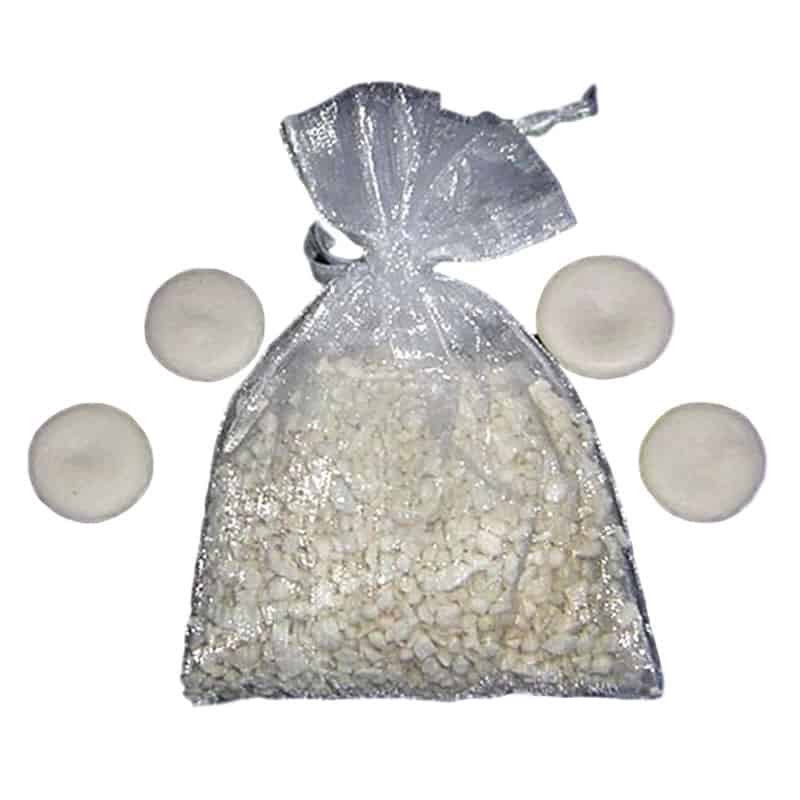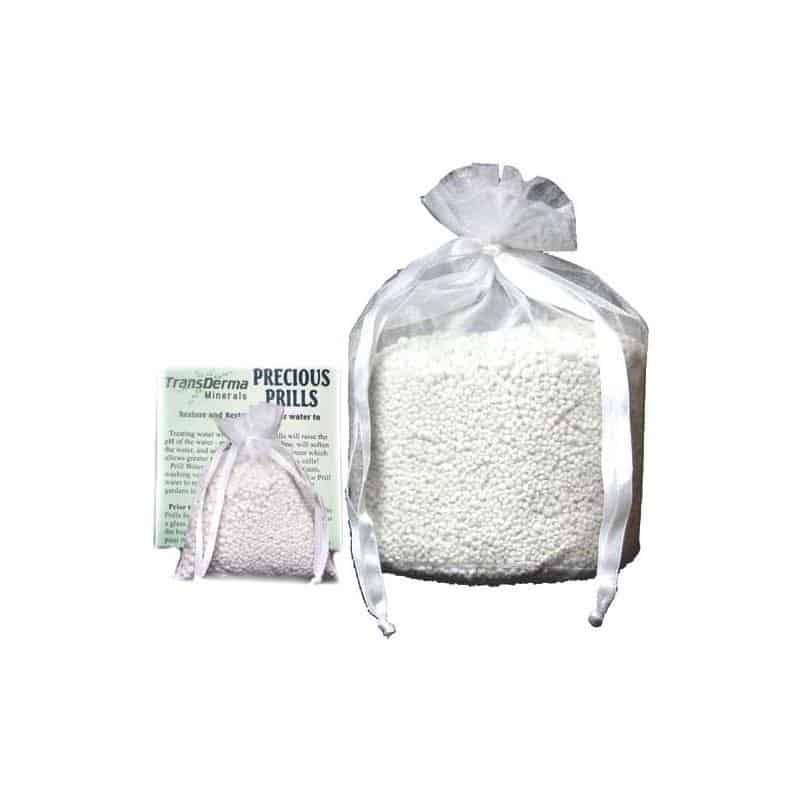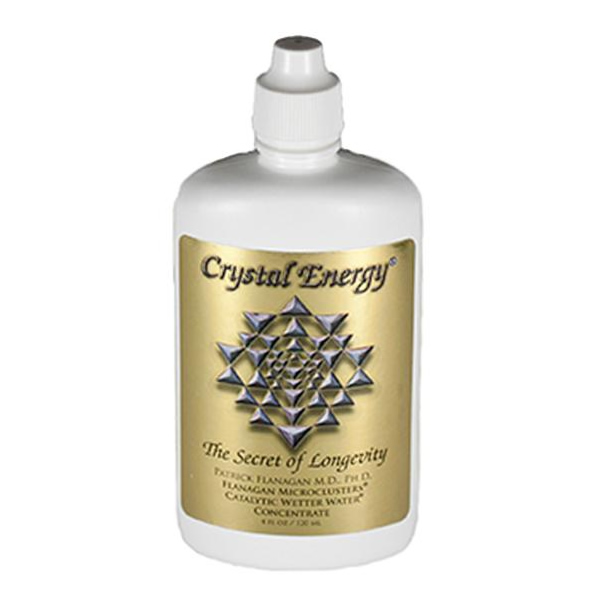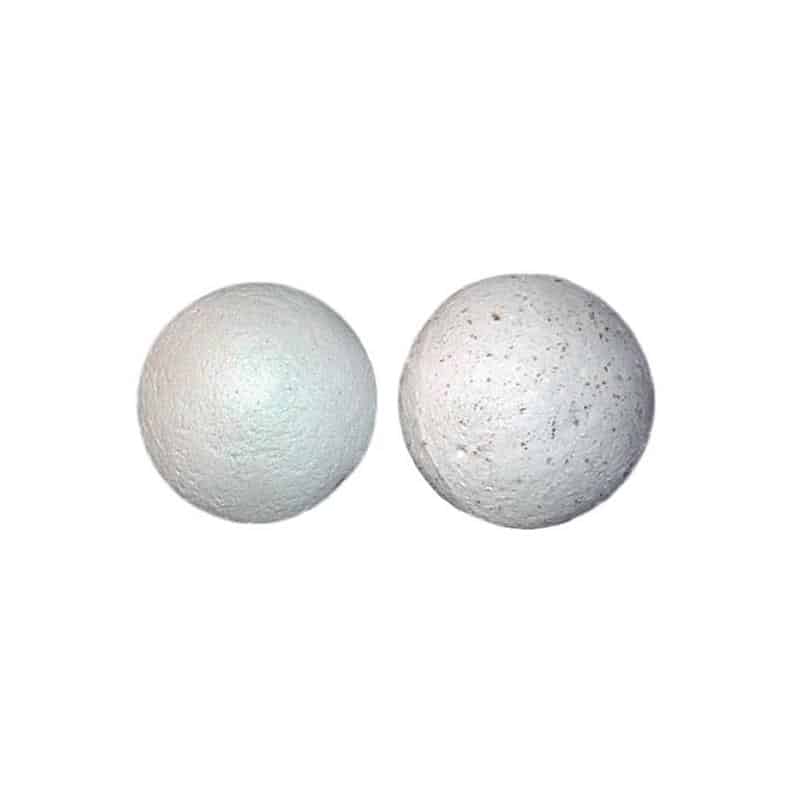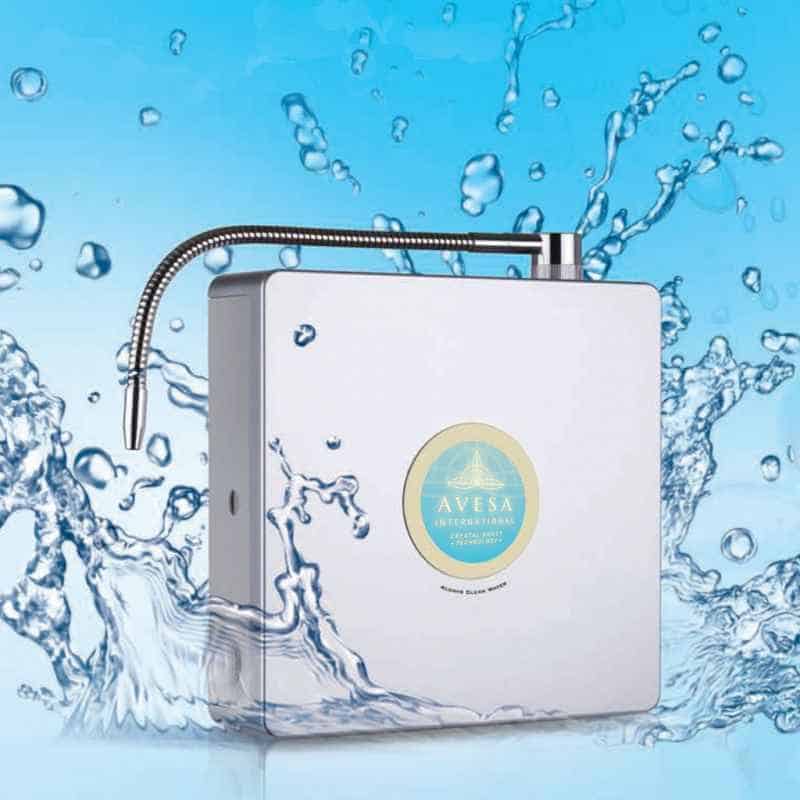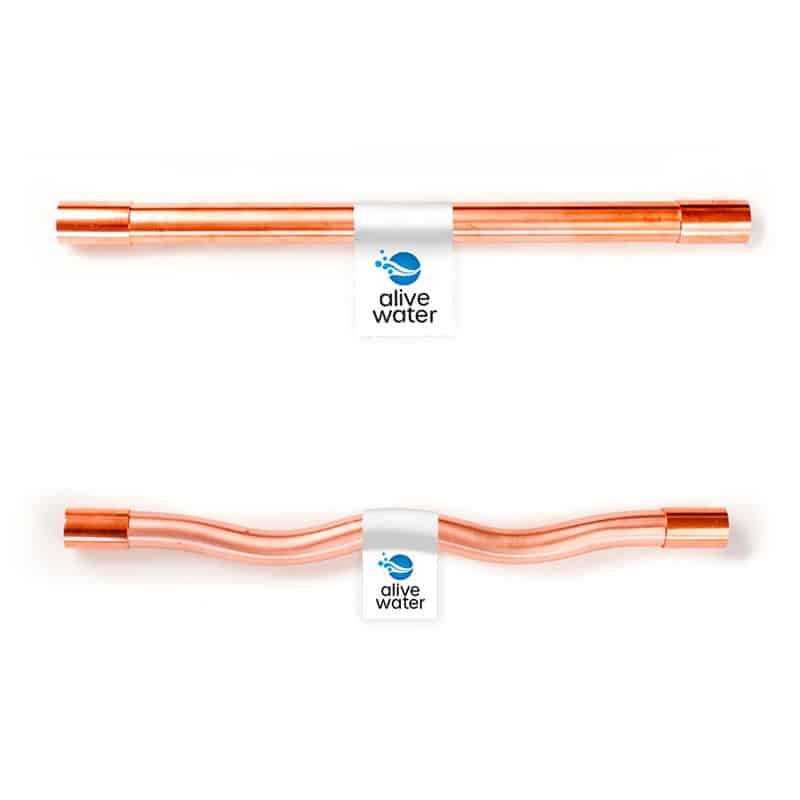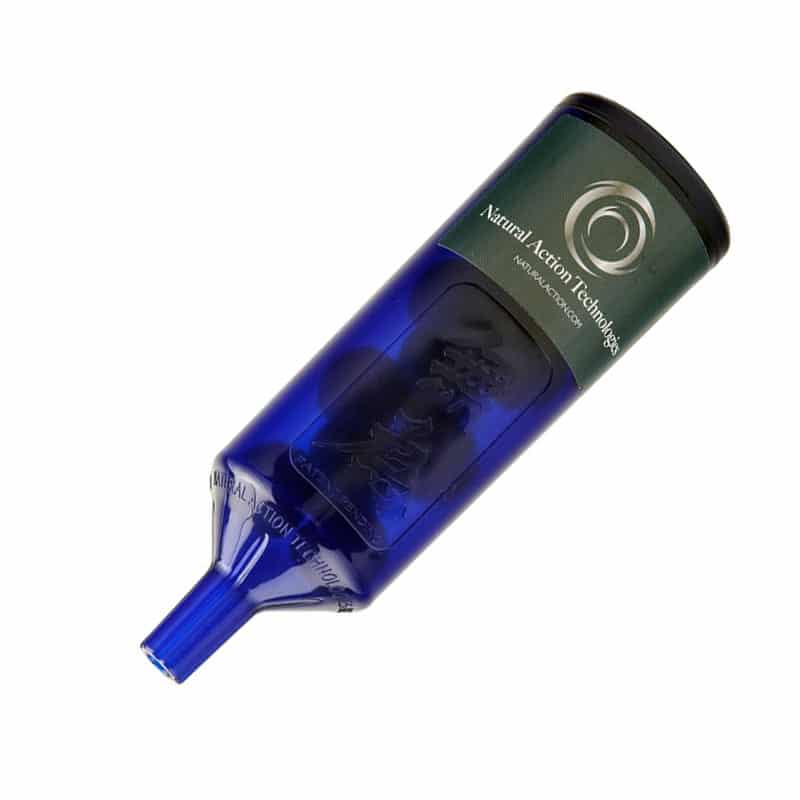No products in the cart.
Energized Water by Dr. Ron Cusson
For quite some time readers have been asking if various curative or ‘miracle’ waters they’ve seen advertised can really have any benefits. I guess we’ve all seen these ads, over the years, advertising these types of waters; Willard Water, ionized water, Micro Water, Tachyon water, etc. If we first make the distinction that we’re talking about water that has undergone some kind of structural change as opposed to water that has simply been combined with some type of liquid additive, then the answer is a definite ‘yes’.
The simple fact is that any water that has undergone a structural change is colloidal in nature. So, to give you an understanding of just how these various waters work, we first have to explain a little about the structure of water and the nature of your immune system.
When we take vitamins and minerals in food or as supplements, a large percentage of vital nutrients escape absorption by the body. As we grow older, our ability to absorb nutrients from diet decreases at an alarming rate. This condition cannot be corrected by eating more. Our systems tend to absorb the ‘bad’ nutrients while discharging the ‘good’ nutrients. We daily see obese people who are technically suffering from malnutrition. As we grow older our immune systems decline in function at an average rate of 1% per year.
This system not only defends the body from outside invaders, it is also responsible for cleansing the body of toxins. At the same time that its defending the body from poisons and outside invaders, it is also responsible for creation and feeding of new cells. The immune system is a central computer whose function is to maintain good health. When we reach the age of 18 to 21, the immune system is functioning at peak efficiency. As we age – efficiency begins to decline. When we are younger, we can fight off minor infections but as we grow older innocent infections or colds may turn into life threatening events. All major research into halting or slowing the aging process involves ways to slow down the degradation of the immune system.
Your body’s immune system produces what has come to be called ‘free radicals’, to enable it to rid itself of various types of toxic waste. An atom is composed of a nucleus (the particle in the center) surrounded by a certain number of moving electrons. ‘Free radicals’ are actually oxygen atoms that have one too many or one too few, electrons. Such an atom is called an ‘ion’. Though our bodies do need some free radicals, an excess of them causes very real and very serious illness, including cancer. The only way to rid of free radicals in the system is to give them one more electron. By doing that we change them from dangerous particles to beneficial ones. Some solids are available which achieve this, such as vitamin C and E, as well as a few man-made compounds known as ‘anti oxidants’. While anti oxidants work well – structured water works better, and we’ll explain why a little further on.
That’s one benefit of “structured” water. There are several others including the fact that such water makes the most potent colloids! As you recall, a man-made colloid such as colloidal silver, is created by immersing two electrodes in distilled water (water containing very few minerals) and running an electrical current through the electrodes. If the distilled water is first ‘structured’, the colloidal process produces many more silver micro clusters resulting in a more potent and effective solution. To understand why structured waters are so much better than ordinary water we must take a look at how they’re made.
As everyone knows, water is composed of molecules. A molecule is two or more atoms “stuck” together. An atom is composed of nucleus (the particle in the center) surrounded by moving electrons. Some atoms carry a positive charge and some carry a negative charge. This is important to remember because, depending upon where the atom is “stuck” to the molecule, the entire molecule itself can attain a ‘north’ pole and a ‘south’ pole; in fact it can have several ‘north’ poles and ‘south’ poles! From 9th grade science or from our earlier magnetic articles, you’ll remember that charges that are alike repel each other and opposite charges attract each other. This is the reason that the two atoms of hydrogen “stick” to the single atom of oxygen. The force that holds these three elements together is called the “hydrogen bond”.
You’ll also notice that when two water molecules are in the proper position, this same attraction of opposites will cause them to ‘stick’ together. This action of one molecule being attracted to and sticking to another molecule, forms chains of molecules which, in turn, form different shapes. The attraction between molecules however, is very weak and is often broken and re-formed during normal physiological reactions. We normally call this disassembly and rearrangement of molecules the “chemistry of life”.
Liquid Crystals
This next portion may be a little complicated, though we’ll do our best to simplify it for you. If you’re willing to simply take our word for it, you could skip ahead. If not, here goes:
As we told you, the basic water molecule is made of two hydrogen atoms and one oxygen atom. The angle between the two hydrogen atoms is 104 degrees. Some molecules have more energy than others however and in these the angle is 109 degrees. It’s these energized molecules that form the basis of the ‘liquid crystal’. The centers of these three atoms form a sort of triangle. In three dimensions, this triangle becomes a sort of 3 sided pyramid shape. This shape is called a tetrahedron. The most stable liquid crystal is formed from 8 of these tetrahedron molecules and is called the Stella Octangula. The different charges at the corners give it a high, one sided, polar charge. This high charge gives the molecule a tendency to orient itself in an electric field. That means that when an electric field is applied to this pure water, the alignment of the molecules tends to neutralize the electric field. (This is called the dielectric constant). Its the dielectric constant that makes pure water a very poor conductor of electricity.
The molecules attach to each other in such a way that the charges add up in the same way we get higher voltages by adding batteries in series. When the water molecules are highly structured like this, the power of the hydrogen bond is increased because of the additive charges. It is the power of the hydrogen bond that enables water to wet substances such as a glass, cotton, etc. The positive hydrogen and negative oxygen charges bind to electric charges present on the surface of the substance into which water comes in contact. The reason water does not wet paraffin is because paraffin is a non-polar molecule, and has no electric charge sites for the hydrogen bond to act.
When water begins to freeze, the hydrogen bonds begin to form liquid crystal structures. The basic form of these structures is hexagonal. When ice finally forms, it is composed of tetrahedrons that form larger hexagonal structures as seen in snowflakes. Ordinary water however is not pure H2O. It has a highly complex structure which is composed of random molecules of ordinary water which frantically move around by thermal agitation. (This is called Brownian movement). Each molecule has an energy field which is called the electron orbital. In the singular water molecule, this energy field forms a tetrahedron with two positive charges and two negative charges on the vertices of the tetrahedron.
Within this sea of chaos float liquid crystal structures of water molecule that are highly organized. These liquid crystals consist of water molecules that are joined together by the hydrogen bond. This was predicted in the classical work of J. Bernal and R. Fowler, and was confirmed by x-ray diffraction studies. Tetrahedrons can be joined together in a limited number of ways. These molecule icebergs are made of clumps of tetrahedrons which are stable only in a certain configurations. Intermixed with these multiple tetrahedral crystal structures are free water molecules which are not bound by hydrogen bonds. This is called the ‘sea of chaos’. These molecules partially fill the loose packing regions within the water structure.
What It Means
So, in simplified terms, we could say that ordinary water is composed of highly structured liquid crystals possessing a strong charge separated by unstructured molecules and hydrogen ions, (isolated protons which have lost their electron), which is called “the sea of chaos”. But all water is not ordinary water.
In the living system, water is highly structured, that is, its composed of a high percentage of liquid crystals with a very low percentage of chaotic disorganized molecules. Ordinary water on the other hand is composed of a large percentage of unstructured molecules which contain a small number of structured liquid crystals. There is a constant energy exchange process between structured molecules and those which are not structured. This exchange is brought about by random thermal (heat) motion. When an animal or plant takes in ordinary bulk water it has to create organized liquid crystals before the water can play a vital role in the living system.
This structuring is accomplished by means of natural high energy colloids. High energy means that the colloids have a high electric charge. The living system manufactures these colloids from minerals, albumins, and sugar complexes. These charged colloids act as tiny ‘seeds’ of energy that attract water molecules and form the nucleus of a liquid crystal. Colloids can only act as seed crystals if they have a high electrical potential. The charge on ordinary colloids is not very stable. For our purposes there are two different types of colloids.
The first colloid is found in the living system and is protected from discharge by a lyophilic (solvent preferring) coating such as gelatin, albumin, albuminoids, or collagen. This coating protects the colloid from discharge because the affinity of the coating for water exceeds the mutual attraction of the colloids and ions of opposite charge.
The second type of colloid has a protective coating which is composed of a nonionic (neutrally charged) polymer. These coatings act as electrical insulators and keep the colloids far enough apart to prevent them from discharging. When these colloids approach each other on a collision course pressure builds up between them. This pressure causes solvent fluid (water) to rush between them which then drives the particles apart. This type of colloid is rarely found outside the living system.
Okay, so now that we know what structured water is and what its good for, lets look at how to go about making it “artificially”. Water is extremely sensitive to external energy forces. Dr. Schwenk of Weleda Laboratories has written a very interesting book entitled: Sensitive Chaos. In his book he details the great sensitivity of water to internal and external forces.
All flowing water, though it may appear to be uniform, is divided into many inner surfaces. This may be easier to visualize if you think of water as countless ropes all bundled together and each rope made up of individual strands all entwined together. In a structure such as this you would have many surfaces. In flowing streams, millions of vortexes form when water breaks past stones, sticks and other obstructions. These vortex patterns act as powerful resonant structures as well as energizers and electrifiers for water and colloids.
These vortex flows are one of the secrets of the great sensitivity of water to the forces of the universe. The speed of movement of water in a vortex has a rhythm of its own, it extends and contracts in a rhythmic pulsation. The vortex is really composed of a series of flowing surfaces (like the ropes) all bound together as if by an invisible hand.
These flowing surfaces move at different speeds, slow on the outside and fast on the inside. The speed of movement of water in a vortex multiplied by the radius from the center is a constant. This means that the velocity at the center of the vortex is theoretically infinite. As the forces in a perfect vortex approach infinity the hydrogen bonds of the water molecule cannot sustain the pressure difference and begin to stretch and weaken releasing powerful forces. Water is sensitive to magnetic, electric, gravitational and vibratory influences. It is affected by light, sound and pressure. All these sensitivities are fleeting and the only time water is really sensitive to external forces is when it is flowing.
When water flows, millions of molecular surfaces open up along interior flow lines. These surfaces are stretched like rubber bands and are so sensitive that they can be impressed by the subtle energies of planetary relationships. In one experiment which was duplicated by Dr. Schwenk, repeatable changes were shown in crystallization of various mineral salts which were affected by planetary movements. These energies are captured in water that is undergoing turbulent flow. The moment the flow ceases, the energy of the moment is retained in the water until it is agitated or moved again at which point a whole new set of energies are captured.
But how long the water retains its added energy structure or colloidal form is a very complicated question. The concentration is one factor. Remember, electrically charged colloids act as tiny electrical ‘seeds’ for the formation of liquid crystals. The more colloids we have, the greater the effect on liquid crystal formation. This is true up to a critical colloid concentration. When that point is reached many things can occur – surface tension bottoms out, and the system may become unstable due to too much charge.
Another factor is called the Zeta potential which concerns this charge. As the electrical charge on the colloids increases, the effect on liquid structure also increases. Again we have critical limits – when the charge reaches a certain point the system becomes unstable. If the charge is too low it is also unstable. When system energy is increased, its stability is decreased as it wants to discharge energy into its surroundings. When the charge is too low, colloids cannot repel each other by electromagnetic force and they collide forming polymer bonds losing surface area and energy in the process.
A third factor that must be considered is the size of the colloids. Colloids may be of any size from 100 angstroms to 10 microns. The smaller the colloid the greater is the surface area for a given parts per million quantity. As colloids get smaller, the lifespan or stability of the system increases. If the colloids are too large, or if they’re forced to grow in size or polymerize – surface area decreases, zeta potential suffers, and random collisions cause larger growth. This process is repeated until the system is destroyed.
Another factor effecting the life of the colloid is the purity of the water. The purer the bulk water, the less interference there is to the formation of liquid crystal structures. If water contains minerals that have opposite charges to the colloids, these minerals tend to be attracted to the colloids interfering with the formation of liquid crystals.
The fifth factor that must be considered is the pH of the system. pH is a measure of available free hydrogen (positive charge) and free hydroxyl (negative charge) ions in the liquid. At a pH of 7.0 these ions are in balance. As the pH goes up we have more hydroxyl ions which have a negative charge. As the pH goes down, we have more hydrogen ions which have a positive charge. In colloidal chemistry pH is critical as a change in pH will affect the zeta potential (charge). For every colloidal system there is a perfect pH balance for lifespan and zeta potential. By changing the pH we can raise zeta potential charge to a critical point where surface tension will be at the absolute lowest, but the lifespan of the colloid system may also be at its lowest. For example, by altering the pH balance of a given concentration of liquid crystal colloids we can vary the surface tension from 25 dynes per centimeter to 65 dynes per centimeter. The lifespan of the colloidal system at 25 dynes is a few hours, while the lifespan at 65 dynes is greatly in excess of 150 years!
And lastly, we must consider the time factor. When we add colloids to water we see a change in surface tension that varies with time. For example, when a given amount of colloids are added to water the surface tension may change from 73 dynes to 65 dynes. After thirty minutes we may see a surface tension of 45 dynes. This time factor is due to the time it takes liquid crystals to form around the colloidal ‘seeds’.
Anyone making colloids or ‘structured’ water must take all of these five factors into account in order to create a product that will be as potent as possible while still lasting a reasonable amount of time. Its a delicate balance, as you can see, and it explains why silver colloids made with particles that are too large or into which too much charge has been applied, are of very little value to the customer.
How To Make It
Now, we’ve explained what structured water actually is and how much it differs from normal or ordinary water – especially distilled water. We touched on why its more beneficial but we’d like to go into that a little bit more as well as explaining how to go about making such water. Remember, various trade names have been given to commercial products of this nature – all of which are expensive. Also remember two other facts; colloidal silver made from structured water is far superior to that made from distilled water. And that when these researchers talk about structured water they sometimes refer to it as a colloid – which it is.
As Dr. Patrick Flannagan said, several years ago, when colloids or structured waters are made properly they are of immense benefit. The development of liquid crystal waters has led to a number of other exciting discoveries. These waters which act as mineral carriers or transporters may be used to transport other substances in the living system. Preliminary tests with cut flowers and other plants have shown a 400% increase in water and nutrient uptake when watered with a solution of liquid crystal water. (The control plants were given just distilled water).
What is true for plants may be true for animals. These high energy waters may act as more efficient nutrient carriers. Preliminary experiments with vitamins and herbal extracts show a definite increase in absorption. Riboflavin, vitamin B2 is an easy vitamin to measure in urine. Testing with riboflavin has shown an increased absorption of 500% when taken with liquid crystal colloids versus distilled water.
One of the most celebrated and encouraging scientific works of our century has been the work of Dr. Alexis Carrel. Dr. Carrel, working at the Rockefeller Institute, won the Nobel Prize in Medicine by demonstrating this arresting hypothesis: “The cell is immortal. It is merely the fluid in which it floats which degenerates. Renew this fluid at intervals, give the cells what they require for nutrition and, as far as we know, the pulsation of life may go on forever.”
An infant at birth has an average body water content of 97%. By the time we reach adulthood, our average water content is 70%. As we age the average water content decreases along with flexibility, youth, and vital bodily functions. What displaces the water so vitally needed by the cells? The answer is of course inorganic minerals and toxins which are stored in the cells. Since liquid crystal waters increase water uptake in plants by 400% its possible that these may increase the vital content of the cells by washing away toxins. Studies show that there is not one area of human life that high energy colloids cannot improve. Those, by themselves, are very good reasons why we should all be drinking structured water. However, structured water has additional advantages not yet mentioned.
Daryl Tichy explained his view and method his way. “Enzymes are a critical ingredient to good health. Ordinary water, including distilled water, supports rather weak electrical activity and therefore exerts correspondingly weak influences on enzyme activity. By spinning water around a specially designed crystal, structuring of the water takes place, through the induction of a small electromagnetic charge. Our measurements show the magnetic component f this charge to be about 0.07 gauss in the structured water. The structuring of water has an increased pH and the ultraviolet spectrophotometer shows increased ultraviolet absorption because of increased hydrogen bonding.”
Structured water assumes a liquid crystalline state by becoming ionized from the crystal’s electromagnetic charge and forming chains of water molecules through hydrogen bonding to oxygen on adjacent water molecules. This happens in distilled water or water with 0.01% silicic acid and persists even after the silicic acid water has been boiled. Any ions or other molecules in the water will increase this structuring effect because the structured water will also form around the ions and molecules. Ions within structured water are characterized by high-energy bonding in which the hydrogen shells around each of the ions have been increased. In other words, the distance between ionized atoms or molecules has been expanded. (An analogy, in very unscientific terms, would be that instead of thousands of tiny specks filling a water drop you’d have several larger clumps surrounded by relatively clear water).
How Does It Affect Your Body?
The amount of structured water in human cells, varies from tissue to tissue. Nuclear magnetic resonance studies show two fractions of cell water, a small fraction of 10% – 25% with a very high degree of structuring and the rest with structuring moderately greater than bulk water. Other studies show 25% – 33% of this intracellular water behaves differently than bulk water.
There are three types of water in skin cells. The first two are of the hydrogen bond type. They comprise about 40% of the total cell water and will not freeze at -50C. The third type, about 60% of the total cell water, and is a bulk-type water which does freeze at -50C.
The structured water surrounding an enzyme affects the enzyme activation process. The increased charge separation of the activated water produces more structured water around the enzymes, resulting in a more energetic folding of the enzyme chains, thereby increasing the rate of enzyme reactions. Another extremely good reason to drink structured water. But – there’s more. Structured water makes a colloid that is many, many times better than one made with ordinary distilled water!
Think about the explanation we gave you earlier and you’ll see why. In layman’s terms you could say that the structured water concentrates the disorganized water atoms into liquid crystals which are then surrounded with relatively “empty” water.
Now consider manufacture of colloidal silver: Positively charged silver atoms are introduced into water. Some adhere to the negative points of the liquid crystals turning them into positive points. With all the liquid crystals now having nothing but positive points. Additional positively charged silver does not “adhere” to the crystals but rather, stays in suspension by the repelling action of “like charges”. The resulting colloid will accept more silver and keep it in suspension much longer than a colloid made with plain distilled water. What’s more, this silver colloid, being made from a water that more closely resembles the water found within your body and it’s cells, is assimilated much more rapidly and thoroughly – and is thus, more effective.
Structured water is very desirable. Trouble is, everybody selling finished treated water charges for it, and shipping costs make this water unaffordable. Do we have to do without? No! We can make our own!
Where Science and Voodoo Meet
The making of structured water isn’t really new. Experiments of this type have been going on for years. Ditto for the knowledge that pure silver can effect microbes. However, some of the earlier experiments showed very startling results – results that prove to be just as true today as they did over 60 years ago. One of these is the fact that planetary movements can – and do, affect colloids and structured water.
George Lakhovsky reported on some interesting experiments he has carried out. It is possible to sterilize water and other liquids through direct contact with metallic conductors. He found that the sterilizing effect of the metal was different according to the phases of the moon. The metal used was silver. In April 1929 (full moon) 26 hours were necessary to sterilize the water; the following month, again during full moon, 40 hours; on the 18th June, the experiments being carried out 4 days before the full moon (full moon on the 22nd June) the contact with silver even produced the opposite effect; instead of sterilizing the water, the bacterial growth was enhanced. During the waning moon the water was sterilized in from 6 to 7 hours. These experiments have been carried out in two different laboratories in the “Salpetriere” and “l’Institut Pasteur.”
These experiments are extremely interesting. Lakhovsky uses as contact metal “Silver.” That means he used a metal which is especially apt to be influenced through the moon. In the year 1929 when Lakhovsky made these experiments the book “Das Silber und der Mond” (Silver and the Moon), was published outlining experiments carried out in the Biological Institute at the Goetheanum in Stuttgart, Germany. This publication showed, by means of experiments make with filter paper, that a solution of silver salt produced different effects if used during full moon or new moon.
This planetary movement also has a direct effect upon water – of all types providing it is moving. The formative boundary surfaces of water in flowing movement prove to be areas of sensitivity. They respond to the slightest changes in their surroundings by expanding, contracting or making rhythmical waves. Water creates an infinite variety of these surfaces and is therefore not merely an inert mass, as we usually think. It is interwoven with countless sensitive membranes, which are prepared to perceive everything taking place in the surroundings. Water is not enclosed within its inner surfaces but open to its surroundings and to all the stimuli and formative impulses from without. It is the impressionable medium par excellence. Indeed it is so sensitive that not only does it react to changes in its immediate surroundings, but also to the delicate, imponderable influences of the planetary universe. This may seem an exceedingly bold statement. But experiments in this field show that water really is capable of reacting to the delicate influences resulting from changes in the cosmos.
For instance, water shaken in a vessel can be caused to move in such a way that the inner surfaces thus created all slide past each other in the moving liquid. As soon as the movement ceases, the formation of inner surfaces, and thus also the great impressionability, is arrested, and the “sense organ” closes itself. If water is shaken in this way, all the many forms of movement arise in it which we have been describing singly for the sake of clarity. (This is why we’ve always recommended shaking your colloids before use). The same is true of the natural movement of water, in which also a great variety of movements combine. Not only the shaking of a container but also other kinds of movement can open up the water as a sense organ.
As a striking example among the abundance of constellations in the heavens we will choose an experiment made on the day of a total eclipse of the sun. During the course of the day at regular intervals – say every quarter hour – a different vessel filled with water is shaken rhythmically for a short time. Each time this is done a kind of sense organ, which closed again when the movement ceases, is opened to the momentary happenings in the heavens. And each time a somewhat different situation in the universe is imprinted upon the water: the gradual movement of the moon towards the sun, the commencement of the eclipse, the totality of the eclipse and the gradual movements of the moon away from the sun. At the end of a series of experiments like this the whole course of the happenings of the day is contained in the row of bottles that have been shaken. How can this be made visible? There are various methods, of which we have chosen the following: in the water of each vessel grains of wheat are caused to germinate; this can be done days or even weeks later, as long as the water has not meanwhile been disturbed anew. The grains of wheat are all placed in the water at the same time and under same external conditions; the effect of the impressions which permeate the water will be seen in the growth of the blades. During the same span of time the blade in the water of one vessel will grow better that in another. The lengths of the different blades in the different vessels will depict the course of the eclipse.
The blades grown in the water shaken at the time of the total eclipse do not grow as high as those in water shaken before or after. A graph can be made of the lengths of the blades in the consecutive samples of water and the so-called growth curve results. Other planetary constellations will give growth curves of a different character.
A stream, bubbling merrily over stones forms countless inner surfaces and tiny vortices, which are all sense organs open to the cosmos, and which perceive the course of events in the heavens. Water passes on the “impressions” it has received wherever it is absorbed by the earth and the plants, by the animals and man. In moving water the earthly world thus allows the ever changing life in the universe of the stars to flow into the course of its own life.
Cosmic events and water are linked with the stream of time in the ebb and flow of the tides – in high tide and low tide. The connection between the course of the moon and the tides is so obvious and well known that we need not go into it in detail here.
On a smaller scale, too, the rhythms of the moon pulsate in the water. In olden times these rhythms were taken into account when wells were dug. This was usually done only during certain phases of the moon and when it was in certain positions in the zodiac. Even within the earth, water rises and falls with the course of the moon. When the moon is in certain positions, water is soon reached, but it also dries up again more easily. At other times it is necessary to dig deeper in order to reach the water, but it then remains constant. Recent observations in deserted and flooded mines show how the subterranean water reservoirs are influenced by the rhythms of the moon. Traditional customs among lumbermen, to the effect that the rivers spread out at full moon and burrow in the depths at new moon, show that the forms of movement within the water obviously have a particular connection with the course of the moon and its phases. Accordingly, in naturally flowing rivers, it is difficult to float the logs at full moon, as they are washed up on banks, whereas at new moon they are drawn into the middle of the waterway and are thus easier to control. It is gradually becoming evident that observations like this from everyday experience in the past are not to be put aside lightly.
George Lakhovsky (of Multiwave Oscillator fame) was always interested in frequencies and oscillation. He propounded a theory back in the 20’s concerning oscillation in human cells. This is what he said about it: In order to prove the validity of my theory of cellular oscillation I recently carried out a series of investigations at the Pasteur Institute. As microbes or cells can live only by virtue of their high frequency oscillation and bearing in mind the bactericidal action of metals I concluded that according to my theory the following facts provided a basis for a rational explanation. It is known that the frequency of an oscillating circuit is modified by contact with a metallic substance which in some way short-circuits it. From this I deduced that the same phenomenon should occur in the cellular oscillating circuit that is to say by contact of metal with microbe.
Modifications In Cells
The experiments carried out at the Pasteur Institute confirmed once more my theoretical views and formed the subject of the following communication presented by Professor d’Arsonval to the “Academie des Sciences” on April 15 1929.
The bactericidal power of silver has been known for some considerable time. Desiring to test the action of metals on microbes according to my theory of cellular oscillation which states that the nucleus of every cell or microbe is comparable to a high frequency oscillating circuit and knowing that the frequency of oscillation any circuit is modified by contact with a metallic substance I concluded that the bactericidal action of the metal was purely physical and due to alteration of oscillation of the nucleus in direct contact with the metal.
From a hygienic point of view the conclusion is that a new process is available for the sterilization of water without boiling (which renders it unpalatable and deprives it of certain mineral salts) and without adding chemical substances which affect its purity to a certain degree and lastly without using filters which are not always effective. These experiments were the forerunner of the illustration we used in our original presentation of colloidal silver. (The interesting thing about all of these observations is the coincidence of its similarity to some of the work of Wilhelm Reich when working with Orgone energy. Reich you may recall made use of one of his orgone devices by placing it over a fast moving stream of water).
Let’s Sum Up
Structured water is good for you your pets and your plants all by itself and its great for making colloidal silver. So how do you go about making it and will it be as good as the “commercial” kind? For the answer to that let me just say that water can only be structured so far and no further. The methods we’ll show you will produce various amounts of structuring with the “best” being ‘way up there’. As to the “how” let’s take a look at what we know.
Water is not one solid mass of liquid. It actually consists of layers. When these layers slide by each other as when they are shaken or otherwise turbulent the surfaces of the layers are susceptible to absorbing an electromotive force or energy. We’ve already seen that some sort of force or energy from the moon effects them but so do other types of energy. The energy derived from prayer has proven to be effective as does the energy from a person deliberately visualizing a beneficial white light entering the water from his hands or eyes. (Both have been proven via an electron microscope).
A magnetic field applied at this time also has a definite effect. But before we jump to any conclusions consider one other factor. Maurice Vogel was a researcher who worked for General Electric. He wrote one of the earliest definitive tests on magnetism. He discovered that water swirled in a clockwise vortex (like when you stir it swiftly with a spoon) develops its own magnetic field of .07 gauss and becomes a permanent magnet! (That’s why Daryl Tichy creates a vortex around a specially cut crystal. The crystal enhances the magnetic field through a piezo electric action).
All this means that we can structure water in several different ways; by simply shaking it vigorously; by shaking it while its within a magnetic field; by running it through or over small obstructions (like quartz crystal pebbles) that create tiny eddies or vortexes behind each pebble; by doing the same in a magnetic field; by creating a vortex in the water or by creating a vortex and applying a magnetic field to it at the same time. All of these things will result in varying degrees of structure within the water.
Which of these methods will produce the maximum efficient structuring? Lets look at the worst first. Simply putting the water into a closed container placing 2 magnets on either side of the container and shaking vigorously for 1 minute will produce a slight structuring – hardly enough to bother with.
The vortex combined with the magnetic field is the best. Providing you remember to take into account the Zeta potential – one of the 5 essential factors that determines a colloids life and effectiveness. Too much of a magnetic charge can make your structure (and its resulting colloid) almost worthless. In between is the stirring method. Put the water into a cup or glass and stir it with a magnet swiftly enough for a vortex to form in the liquid. Stir for 30 seconds. Let the water stand for 6 minutes at least. This produces structuring four times better than the shaking method. Repeat the stirring method after the first 6 minutes and you’ll make it almost as good as the funnel method which follows.
With the funnel method you acquire a funnel that produces a vortex of swirling of the water as it empties. Not all funnels will do this. The swirl should be in a clockwise direction. Attach one or two magnets to the outside of the funnel on opposite sides down near the narrow end with the positive side and negative sides in toward the funnel. Pour the water through the funnel (making sure of the swirling action). Let stand at least 6 minutes and repeat. This method produces an excellent structure but it only works well if you’re doing a quart or more at a time.





